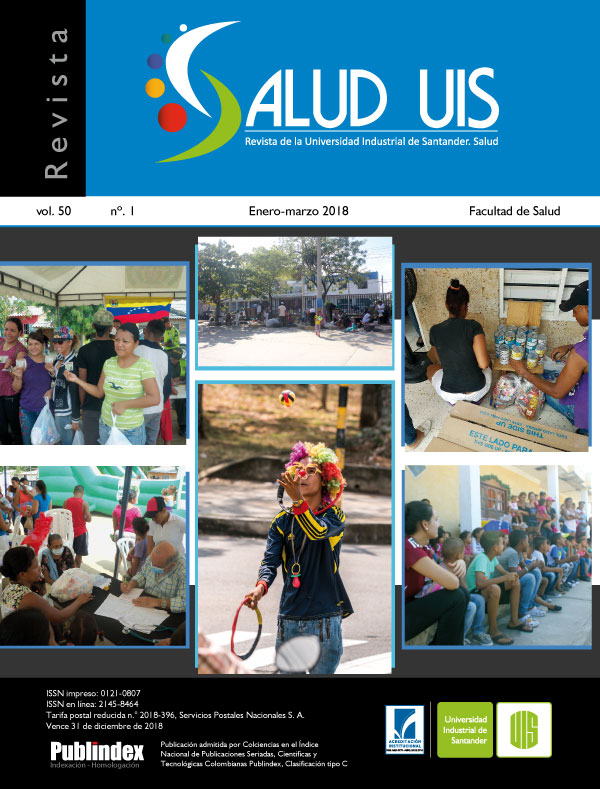Resumo
Introducción: La hemofilia es el trastorno hemorrágico congénito más frecuente en los varones, los pacientes con enfermedad severa pueden tener sangrados espontáneos que llevan a discapacidad. Objetivo: Describir las características de los sangrados y los aspectos clínicos y demográficos de un grupo de pacientes con diagnóstico de hemofilia en un centro de referencia de la ciudad de Bogotá. Materiales y métodos: Estudio descriptivo de serie de casos, en menores de 18 años con hemofilia, entre mayo 1 a diciembre 31 de 2014. Resultados: Se incluyeron 51 pacientes, 33/51 tuvieron sangrado, 109 sangrados, el sangrado más frecuente fue hemartrosis y en niños con anticuerpos inhibidores. 22 pacientes tenían hemofilia severa, 18 moderada y 11 leve. 18/22 pacientes severos sangraron y tuvieron 87 sangrados, 14/18 (77%) pacientes con artropatía tuvieron sangrado, con 74 eventos en total, 19/33 pacientes sin artropatía tuvieron 35 eventos. El grupo con mayor frecuencia de sangrados tenía entre 5 y 9 años. De los 81 episodios traumáticos, la mayoría fueron jugando y haciendo deporte; Se presentaron 19 sangrados espontáneos y nueve relacionados con procedimientos. 84 sangrados fueron en temporada escolar y 25 en vacaciones. Al momento de los sangrados en 76 episodios estaban acompañados por padres o familiares y 69 episodios ocurrieron en el hogar (62,4%). Conclusiones: Los sangrados fueron más frecuentes en niños con anticuerpos inhibidores, enfermedad severa, con artropatía, en temporada escolar y estando acompañados. No hubo mayor frecuencia de sangrados en aquellos con disfunción familiar.
Referências
2. Konkle BA, Huston H, Nakaya SF. Hemophilia A. En: Adam MP, Ardinger HH, Pagon RA, Wallace SE. GeneReviews. last revision: June 22, 2017. Seattle: University of Washington, Seattle; 1993-2017.
3. Srivastava A, Brewer AK, Mauser-Bunschoten EP, Key NS, Kitchen S, Llinas A, et al; Treatment guidelines working group on behalf of the world federation of hemophilia. Guidelines for the management of hemophilia. Haemophilia. 2013; p. 1-47.
4. Gringeri A, Lundin B, Von Mackensen S, Mantovani L, Mannucci pm, and The ESPRIT Study Group. A randomized clinical trial of prophylaxis in children with hemophilia A (the ESPRIT Study). J Thromb Haemost. 2011; 9(4): 700-710. DOI: 10.1111/j.1538-7836.2011.04214.x.
5. Acharya SS. Advances in hemophilia and the role of current and emerging prophylaxis. Am J Manag Care. 2016; 22(5 Suppl): 116-125.
6. Valentino LA, Mamonov V, Hellmann A, Quon DV, Chybicka A, Schroth P, et al. A randomized comparison of two prophylaxis regimens and a paired comparison of on-demand and prophylaxis treatments in hemophilia A management. J Thromb Haemost. 2012; 10(3): 359-367. DOI: 10.1111/j.1538-7836.2011.04611.x.
7. Manco-Johnson MJ, Abshire TC, Shapiro AD, Riske B, Hacker MR, Kilcoyne R, et al. Prophylaxis versus episodic treatment to prevent joint disease in boys with severe hemophilia. N Engl J Med. 2007; 357(6): 535-544.
8. Zhao Y, Xiao J, Yang R, Wu R, Hu Y, Beckmann H, et al. Efficacy of standard prophylaxis versus on-demand treatment with bayer´s sucroseformulated recombinant FVIII (rFVIII-FS) in chinese children with severe hemophilia A. Pediatr Hematol Oncol. 2017; 34(3): 138-148. DOI: 10.1080/08880018.2017.1313921.
9. Bertamino M, Riccardi M, Banov L, Svahn J, Molinari JC. Hemophilia care in the pediatric age. J. Clin. Med. 2017; 6(5): PiiE54. DOI:10.3390/jcm6050054.
10. Rodríguez-Merchán EC. Articular bleeding in hemophilia. Cardiovasc Hematol Disord Drug Targets. 2016; 16(1): 21-24.
11. Melchiorre D, Manetti M, Matucci-Cerinic M. Pathophysiology of hemophilic arthropathy. J Clin Med. 2017; 25: 6(7). pii: E63. DOI: 10.3390/jcm6070063
12. Bellón JA, Delgado A, Luna JD, Lardelli P. Validity and reliability of the family Apgar family function test. Aten Primaria. 1996; 18(6): 289-295.
13. Fischer K, Collins P, Bjorkman S, Blanchette V, Oh M, Fritsch S, et al. Trends in bleeding patterns during prophylaxis for severe haemophilia: observations from a series of prospective clinical trials. Haemophilia. 2011; 17(3): 433-438. DOI: 10.1111/j.1365-2516.2010.02450.x.
14. Morfini M, Haya S, Tagariello G, Pollman H, Quintana M, Siegmund B, et al. European Study on Orthopaedic Status of hemophilia patients with inhibitors. Haemophilia. 2007; 13: 606-612.
15. Dekoven M, Karkare S, Lee WC, Kelley LA, Cooper Dl, Pham H, et al. Impact of haemophilia with inhibitors on caregiver burden in the United States. Haemophilia. 2014; 20(6): 822-830. DOI: 10.1111/hae.12501.
16. Valentino LA. Assessing the benefits of FEIBA prophylaxis in haemophilia patients with inhibitors. Haemophilia. 2010; 16(2): 263-271. DOI: 10.1111/j.1365-2516.2009.02126.x.
17. Lentz SR, Cerqueira M, Janic D, Kempton C, Matytsina I, Misgav M, et al. Interim results from a large multinational extension trial (guardianTM2) using turoctocog alfa for prophylaxis and treatment of bleeding in patients with severe haemophilia A. Haemophilia. 2016; 22(5): e445-449. DOI: 10.1111/hae.12990.
18. Ozelo M, Villaca PR, Perez-Bianco R, Candela M, Garcia-chavez J, Moreno-Roodrigez B, Rodriguez MB, et al. Musculoskeletal evaluation in severe haemophilia A patients from Latinamerica. Haemophilia. 2014; 20(1): e63–e70. DOI: 10.1111/hae.12316.
19. Fischer K, Astermark J, Van Der Bom G, Ljung R, Berntorp E, Grobbee DE, Van Den Berg HM. Prophylactic treatment for severe haemophilia: comparison of an intermediate-dose to a high-dose regimen. Haemophilia. 2002; 8(6): 753-760.
20. Hofstede Fg, Fijnvandraat K, Plug I, Kamphuisen P. W, Rosendaal Fr, Peters M. Obesity: a new disaster for haemophilic patients?A nationwide survey. Haemophilia. 2008;14:1035-1038.
21. Ullman M, Zhang QC, Brown D, Grant A, Soucie JM. Haemophilia treatment center network Investigators. Association of overweight and obesity with the use of self and home-based infusion therapy among haemophilic men. Hemophilia. 2014; 20(3): 340-348. DOI: 10.1111/hae.12303.
22. Kulkarni R, Karim FA, Glamocanin S, Janic D, Vdovin V, Ozelo M, et al. Results from a large multinational cinical trial (guardian 3) using prophylactic treatment with turoctocog alfa in paediatric patients with severe haemophilia: safety, efficacy and pharmacokinetics. Haemophilia. 2013; 19(5): 698-705. DOI: 10.1111/hae.12165.
Se autoriza la reproducción total o parcial de la obra para fines educativos, siempre y cuando se cite la fuente.
Esta obra está bajo una Licencia Creative Commons Atribución 4.0 Pública Internacional.
